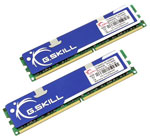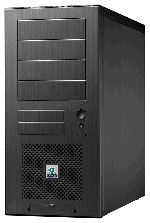Intel Midrange Workstation
We'll wrap things up with a nice quad-core "workstation" that might be used for more serious work. We're not talking about a workstation that can compete directly with a high-powered 3D rendering workstations (at least not without spending some additional money), but this is still a computer that packs a lot of punch and would be suitable for software development, video editing, graphics artwork, etc. Again, overclocking isn't going to be a serious consideration; certainly this configuration is capable of some overclocking, but stability is going to be a far bigger concern.
| Intel Midrange Workstation |
| Hardware |
Component |
Price |
Rebates |
| Processor |
Intel Core 2 Quad Q6600 (2.40GHz 1066FSB 2x4MB Shared) - Retail |
$278 |
|
| Motherboard |
ASUS P5K-E/WIFI-AP (P35 ICH9R) |
$155 |
|
| Memory |
G.Skill 2x2GB PC2-6400 (F2-6400CL5D-4GBPQ) |
$170 |
|
| Video Card |
Powercolor Radeon HD 2600XT 512MB (26XT512M/D3HDMI) |
$142 |
|
| Hard Drive |
Western Digital Caviar SE16 320GB 7200RPM 16MB (WD3200AAKS) |
$80 |
|
| Optical Drive |
Samsung 20X DVD+R SATA (SH-S203B) |
$36 |
|
| Case |
Lian Li PC-7B plus II |
$106 |
|
| Power Supply |
Seasonic S12 Energy Plus SS-650HT |
$149 |
|
| Display |
Acer AL2216Wbd 22" 5ms (1680x1050) |
$235 |
|
| Speakers |
Logitech X-140 5W 2.0 Speakers |
$27 |
|
| Keyboard and Mouse |
Microsoft Comfort Curve 2000 (B2L-00047) |
$28 |
|
| Operating System |
Windows Vista Home Premium 64-bit (OEM) |
$110 |
|
| Bottom Line |
$1516 |
$1516 |
 |
Obviously, the biggest change from the previous configurations is that we are using a quad-core processor. Intel's cheapest Core 2 Quad, the Q6600, now easily allows people to create a quad processor system that can outperform 2P systems from just two years ago, all at a much lower cost. Still, $278 for a "midrange" processor isn't exactly cheap. In order to make room for the added expense, we have trimmed some other areas. Looking at the overall configuration, however, you can see that we didn't have to compromise much.
 |
For the motherboard, we chose the ASUS P5K-E/WiFi-AP, which uses the P35 chipset. This is definitely not an inexpensive motherboard, but if we had to choose one motherboard brand that provides overall better stability than just about anyone else (outside of the server motherboard market), we would choose ASUS. That's not to say that ASUS is perfect - there have been a few problem releases over the years - but by and large they are one of the "safe bets" when it comes to overall quality. Getting WiFi support is simply an added bonus.
 |
For the memory configuration, we have upgraded to 4GB of RAM (in a 2x2GB setup). Naturally, we are also recommending a 64-bit version of Windows Vista. Overall compatibility with the 64-bit operating system has gotten a lot better since Vista's launch, and if you're going to open up a lot of applications at once having more memory really speeds things up. All we need now is to get more native 64-bit applications, but at least we'll be ready when they arrive. In fact, if you really want to take things to the extreme, you can try running a 4x2GB configuration. We haven't had the chance to verify that this works properly yet, but we hope to do so in the near future. In the meantime, we can verify that 2x2GB works fine. In terms of raw performance and overclocking, a 4x1GB configuration is better, but since this is a workstation losing a few percent performance and skipping out on overclocking isn't really a problem. The option to add more memory in the future is far more important.
For the graphics card, we wanted to make sure that we selected something that included a dual-link DVI output. No, we're not going to be able to fit a 30" LCD into our midrange components, but a true workstation environment might want to add one in the future. The Powercolor Radeon HD 2600 XT provides two dual-link outputs, plus an HDMI adapter. The 512MB of memory may not really help much, but Windows Vista is able to do a bit more with graphics card memory so it certainly won't hurt either. For alternatives, the 8600 GT/GTS all support at least a single dual-link DVI connection and cost about the same amount (though with half the amount of RAM). If you want a Linux workstation (or you're planning on dual-booting at least), NVIDIA cards remain the better option, despite
AMD's latest efforts.
The remaining component selections are mostly the same, except that we switched to a Lian Li case that we felt was a bit classier looking and more in tune with a workstation design, and we also upgraded to a Seasonic S12 650W power supply. Neither of these upgrades is strictly necessary, but we do feel that they provide a bit better overall package. We also downgraded the keyboard, mouse, and speakers; naturally, some people will prefer some other brand of input device, but we've always felt that the Microsoft Comfort Curve 2000 is a good baseline recommendation.
The total comes to almost $1516, and honestly we would really like to have a larger LCD. Trimming costs in a few areas in order to fit a 24" LCD into the picture might be possible, but with 24" LCDs now starting at $400 for basic models we would probably just spend the extra money instead. That's not to say that the quality of a cheap 24" display is the same as what you might get with some of the $600 24" LCDs, but the increased native resolution alone is worth the price of entry.
Conclusion
As usual, even after four midrange systems, we've hardly scratched the surface of what's possible. There are numerous tweaks that could be made in order to save a few dollars or increase performance in a specific area, but for those of you looking for a "State of the Midrange Industry Address" we have hopefully provided you with a good starting point. While there are plenty of new products that are just around the corner, we would also like to warn against paralysis by analysis. No matter when you look at building a new system, there will always be newer/faster parts coming out within the next couple of months. If you're at the point where you need a new system, we recommend taking the plunge and not looking back. After all, no matter what you buy, you'll probably be looking at putting together a new system again in just a couple more years.
10/29/07 Update: As many of you are probably aware, the NVIDIA GeForce 8800 GT is now available. Given the price and performance, not to mention other benefits such as power requirements and a single slot design, we can see absolutely no reason to even consider the 8800 GTS 320 cards any longer. The 640 cards do come in slightly faster in a few specific situations, but overall we'd take the 512MB 8800 GT. In fact, if you were previously thinking of an 8800 GTX/Ultra, 8800 GT SLI is almost certainly the better option now (barring price cuts). We won't be updating the rest of the article text, but this is an important enough announcement that we wanted to make sure our Midrange Guide doesn't mislead anyone.














41 Comments
View All Comments
cosmotic - Monday, October 15, 2007 - link
It would be really cool if you guys built the Intel and AMD system's and put them head to head in benchmarks.